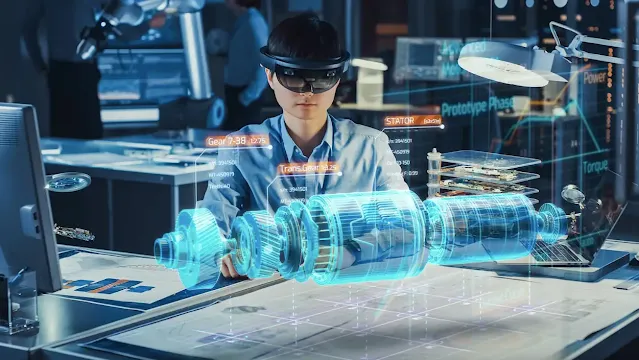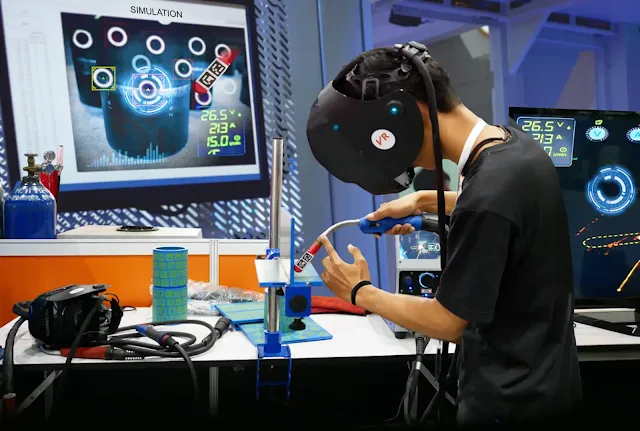Estimated Reading Time: 5 minutes
What Is Augmented Reality (AR) and How Is It Used in Industries?
Augmented Reality (AR) is a rapidly evolving technology that combines digital content with the real world, enhancing how we interact with our environment. Unlike Virtual Reality (VR), which immerses users in a completely digital environment, AR overlays computer-generated images, sounds, or other sensory enhancements onto real-world views. AR can be experienced through various devices such as smartphones, tablets, and specialized AR glasses. As its applications become more widespread, industries are finding innovative ways to integrate AR into their processes to improve efficiency, engagement, and customer experiences.
In this article, we will explore the basics of AR, its key features, and how it is being applied in different industries. Additionally, we will discuss its impact on businesses and how it is shaping the future of various sectors.
What is Augmented Reality (AR)?
At its core, Augmented Reality (AR) is the integration of digital information with the user’s environment in real-time. It enhances the physical world with virtual elements, creating a seamless interaction between the two. AR technology can use a camera to capture the environment and sensors to track objects or movements. Through AR devices or applications, users can see these digital objects superimposed on the real world, allowing them to interact with both simultaneously.
The key difference between AR and VR is that AR does not require users to be fully immersed in a virtual world. Instead, it enhances the reality that the user experiences. For example, AR can overlay a set of navigation directions on your smartphone screen as you walk, or it can display detailed information about objects or landmarks when viewed through an AR-enabled device.
Key Features of Augmented Reality
AR has several features that make it a unique and powerful technology:
Real-time Interaction: AR allows users to interact with virtual elements in real-time. Whether it’s pointing a camera at a product or using gesture control, the interaction is immediate and responsive.
Contextualization: AR enhances the real world by providing additional contextual information. For example, while looking at a piece of machinery, AR can display its operational status or repair instructions.
Device Compatibility: AR can be experienced through a variety of devices, including smartphones, tablets, AR glasses, and smartwatches, making it accessible and versatile.
Immersive Visuals: High-quality AR technology offers realistic graphics that blend seamlessly with the real world, making virtual elements appear lifelike and interactive.
How AR is Revolutionizing Various Industries
1. Retail and E-commerce
In the retail industry, AR is transforming the way consumers shop and engage with products. Virtual try-ons, where customers can see how clothes, glasses, or makeup will look on them through an AR interface, are becoming increasingly popular. Major retailers such as IKEA use AR to allow customers to visualize furniture and home decor items in their own space before making a purchase.
Key applications in retail include:
- Virtual try-on experiences for apparel, makeup, and accessories.
- Product visualization, allowing customers to see how products will look in their homes.
- Enhanced in-store navigation with AR, helping customers locate items and offers quickly.
2. Healthcare and Medicine
AR is making significant strides in healthcare, with applications ranging from surgery assistance to patient education. Surgeons use AR to overlay critical information, such as scans and vital signs, on their field of view during procedures, increasing precision and reducing risks. AR also helps in medical training by simulating surgeries and complex procedures in a safe environment.
Key uses of AR in healthcare include:
- Augmented surgical navigation for increased precision.
- Medical training through AR simulations.
- Patient education, with AR providing interactive and visual explanations of conditions and treatments.
3. Education and Training
In education, AR is revolutionizing the way students interact with learning materials. By overlaying interactive elements on textbooks or classroom walls, AR brings learning to life. This immersive technology enhances engagement, making complex subjects like anatomy, physics, and history more interactive and accessible.
AR applications in education include:
- Interactive textbooks and educational materials that come alive with AR.
- Virtual field trips and historical recreations for a hands-on learning experience.
- Simulated practical training in fields like engineering, medical sciences, and aviation.
4. Manufacturing and Industrial Applications
The manufacturing industry benefits greatly from AR by improving operational efficiency and reducing error rates. Workers can use AR to access real-time data, instructional videos, and step-by-step guides while assembling products or repairing machinery. AR headsets can display vital information, such as part specifications, assembly instructions, and quality control checklists, directly in the worker's field of view, reducing downtime and increasing productivity.
Key benefits of AR in manufacturing include:
- Real-time, hands-free guidance for assembly and repair.
- Training workers through AR simulations before they work on actual machines.
- Remote assistance, allowing experts to guide workers through complex tasks via AR-enabled devices.
5. Real Estate and Architecture
In the real estate and architecture industries, AR allows clients to visualize buildings and spaces before they are constructed. Virtual walkthroughs and 3D models help buyers and investors understand the design and layout of properties. Architects can use AR to overlay plans onto the physical world, making it easier to communicate designs with clients.
AR applications in real estate and architecture include:
- Virtual tours of properties, allowing buyers to explore homes remotely.
- Overlaying architectural plans on real-world sites to visualize the final design.
- Interactive features for showing potential renovations or modifications to existing buildings.
6. Automotive Industry
The automotive industry is using AR to enhance vehicle design, production, and user experience. During manufacturing, AR is used for assembly line assistance, helping workers with real-time data overlays. For consumers, AR head-up displays (HUD) in cars project navigation, speed, and other relevant data onto the windshield, reducing distractions and improving safety.
Key applications of AR in the automotive industry include:
- Augmented assembly lines for real-time guidance and error prevention.
- AR-powered navigation systems, displaying directions directly onto the windshield.
- Virtual car customization, where customers can visualize different car models and features.
Future of Augmented Reality
As technology advances, the possibilities for AR continue to grow. The integration of 5G networks, artificial intelligence (AI), and machine learning will enhance the capabilities of AR, making it faster, more precise, and more interactive. In the future, we can expect AR to become a critical tool in even more industries, from smart cities to autonomous vehicles and personalized advertising.
Businesses adopting AR technology are not only enhancing customer experiences but also streamlining operations, reducing costs, and gaining a competitive edge. AR’s potential to transform industries makes it an exciting area for continued innovation and investment.
Augmented Reality is no longer just a futuristic concept – it is an active force transforming industries around the world. From retail and healthcare to education and manufacturing, AR is making processes more efficient, engaging, and intuitive. As AR continues to evolve, it will open up new opportunities for businesses to create value, improve customer satisfaction, and enhance operational efficiency.
As the adoption of AR technology grows, it will be crucial for industries to stay ahead of the curve and explore innovative ways to leverage this powerful tool for growth and success.
Reference Source:
https://www.sap.com/products/scm/industry-4-0/what-is-augmented-reality.html
https://www.youtube.com/watch?v=DG56iV8FcV0

.webp)


